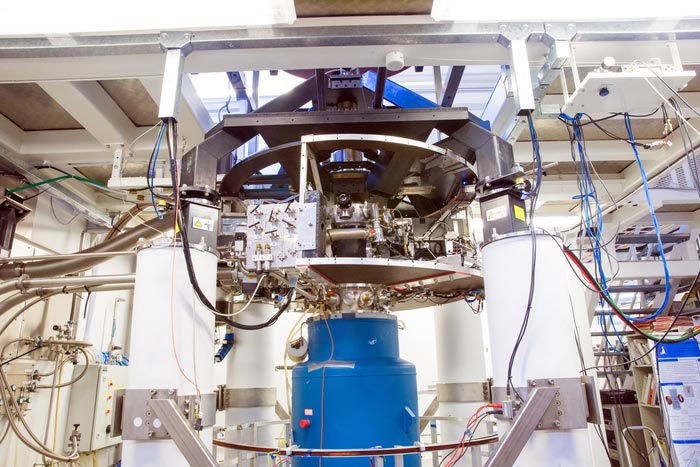Time crystals “impossible” but obey quantum physics

Researchers cooled superfluid helium-3 to near absolute zero (minus 273.15°C) inside this rotating refrigerator, where two time crystals were created and brought into touch.
Credit: © Aalto University/Mikko Raskinen
Scientists have created the first ”time-crystal” two-body system in an experiment that seems to bend the laws of physics.
It comes after the same team recently witnessed the first interaction of the new phase of matter.
Time crystals were long believed to be impossible because they are made from atoms in never-ending motion. The discovery, published in Nature Communications, shows that not only can time crystals be created, but they have potential to be turned into useful devices.
Time crystals are different from a standard crystal – like metals or rocks – which is composed of atoms arranged in a regularly repeating pattern in space.
First theorised in 2012 by Nobel Laureate Frank Wilczek and identified in 2016, time crystals exhibit the bizarre property of being in constant, repeating motion in time despite no external input. Their atoms are constantly oscillating, spinning, or moving first in one direction, and then the other.
EPSRC Fellow Dr Samuli Autti, lead author from Lancaster University’s Department of Physics, explained: “Everybody knows that perpetual motion machines are impossible. However, in quantum physics perpetual motion is okay as long as we keep our eyes closed. By sneaking through this crack we can make time crystals.”
“It turns out putting two of them together works beautifully, even if time crystals should not exist in the first place. And we already know they also exist at room temperature.”
A ”two-level system” is a basic building block of a quantum computer. Time crystals could be used to build quantum devices that work at room temperature.
An international team of researchers from Lancaster University, Royal Holloway London, Landau Institute, and Aalto University in Helsinki observed time crystals by using Helium-3 which is a rare isotope of helium with one missing neutron. The experiment was carried out in Aalto University.
They cooled superfluid helium-3 to about one ten thousandth of a degree from absolute zero (0.0001K or -273.15°C). The researchers created two time crystals inside the superfluid, and brought them to touch. The scientists then watched the two time crystals interacting as described by quantum physics.
Journal: Nature Communications
DOI: 10.1038/s41467-022-30783-w
Method of Research: Experimental study
Subject of Research: Not applicable
Article Title: Nonlinear two-level dynamics of quantum time crystals
Article Publication Date: 2-Jun-2022
Media Contact
Gillian Whitworth
Lancaster University
gillian.whitworth@lancaster.ac.uk
Office: 01-524-592-612
All latest news from the category: Physics and Astronomy
This area deals with the fundamental laws and building blocks of nature and how they interact, the properties and the behavior of matter, and research into space and time and their structures.
innovations-report provides in-depth reports and articles on subjects such as astrophysics, laser technologies, nuclear, quantum, particle and solid-state physics, nanotechnologies, planetary research and findings (Mars, Venus) and developments related to the Hubble Telescope.
Newest articles

Innovative 3D printed scaffolds offer new hope for bone healing
Researchers at the Institute for Bioengineering of Catalonia have developed novel 3D printed PLA-CaP scaffolds that promote blood vessel formation, ensuring better healing and regeneration of bone tissue. Bone is…

The surprising role of gut infection in Alzheimer’s disease
ASU- and Banner Alzheimer’s Institute-led study implicates link between a common virus and the disease, which travels from the gut to the brain and may be a target for antiviral…

Molecular gardening: New enzymes discovered for protein modification pruning
How deubiquitinases USP53 and USP54 cleave long polyubiquitin chains and how the former is linked to liver disease in children. Deubiquitinases (DUBs) are enzymes used by cells to trim protein…


